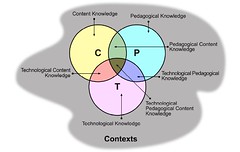 Image by David T Jones via Flickr
Image by David T Jones via FlickrDebra Bath and John Bourke spoke about the results of work they have been doing around a blended learning course at Griffith University. The University focus from 2008 onwards has been on blended learning, and to "...systematically embed BL approaches in the teaching and learning activities of all progams". A course was set up around blended learning to support staff, and four people were appointed.
In the first year there were about 38 enrolments. The course had to embody blended learning, and allowing the students to walk that walk with the facilitators. How can yo utalk and teach about blneded learning unless you give people an opportunity to do it? Two frameworks underpinned the BL course, including TPCK. The TPCK model goes beyond content, pedagogy and technology, but rather is a blending of all three components. The Community of Inquiry model was used to complement the course "avoids the tyranny of adopting clever techniques" (Garrison & Vaughan, 2007, p. 13). The social, cognitive (creating challenge, and searching for / integrating new ideas) and teaching presence were encapsulated in the design of the course.
There were 4 key learning objectives ranging from awareness of philosophies and upskilling in practical skills. The course was structured around 3 f-2-f sessions in non-teaching weeks, 4 x learning modules. and 3 x virtual turorial sessions (Wimba). The small group wiki was used for participants to develop a resource that then became a good tip user guide.
The course was evaluated in a range of ways, including via survey to evaluate the impact of the corse (http://communitiesofinquiry.com).






No comments:
Post a Comment